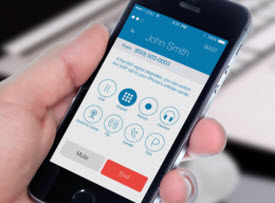Highlights:
- Mobile use in the workplace grew steadily in the last decade, and accelerated during COVID.
- In the hybrid workplace, employees will depend on their mobile devices more than ever to stay connected.
- Choosing a communications provider that’s mobile-first will be key to succeeding in hybrid work. Here’s what to look for.
Work can happen anywhere and anytime—and when it does, employees are ready.
In the last decade, we’ve seen work become increasingly fluid as take-home PCs and smartphones became vital to our work lives. And we fully expect this trend to continue, especially as hybrid work grows beyond the pandemic.
This means that more than ever before, workers will need their devices to support them flexibly wherever and whenever they’re working.
Mobile and the shift to hybrid work
People were already using their smartphones for work long before the pandemic. For example, a 2018 study found that seven in 10 Swiss workers used their phones to perform work-related tasks during their leisure time.
But smartphone usage surged during the pandemic, with people reporting more than a third more texting and video calling from their cell phones. This will likely only continue to grow as hybrid work demands workers to use devices that keep them connected wherever they’re working from.

Smartphones, in particular, fill this need because they’re portable and convenient to access from just about anywhere. Ever quickly check your email while out for the night or before you go to sleep? If you did it from your phone, then you know that smartphones are key to staying connected.
As hybrid work grows and workers increasingly shift in and out of offices, collaboration via mobile app will grow with it. That’s why it’s important to choose the right communications app from the start. One that has just as many features as its desktop counterpart.
Here are four key things to look for:
1. It all starts with the product strategy
Many cloud communications providers build their mobile apps as an afterthought to desktop solutions. However, to meet the needs of a hybrid workforce, it’s a good idea to look for a provider that gives the same level of attention to both their mobile and desktop apps.
For starters, make sure your provider has a mobile-based version of their product. It’s also a good idea to check that their app is not just a pared-down version of the full product. It should offer all of the same features so that anything you can do on desktop, you can also do on a phone.
2. Messaging
Team messaging is one of pillars of how we work together at RingCentral—and really, it’s the foundation for a strong culture of collaboration. In RingCentral, messaging teams are how we ask questions, share files and links, and keep track of projects—things that are essential to working from anywhere.
The RingCentral mobile app provides full access to all of the messaging functionalities of the desktop version—and to all of the information that gets shared there. From @mentions to the ability to share files and links to switching to calls or a video meeting with just a click—you can do it all with our mobile app.
3. Video
Video has become a must-have collaboration tool during the pandemic—and with the rise of hybrid work, it’s going to remain an important part of the communication mix.
As such, employees should be able to access video meetings on the mobile app. And once again, it’s a good idea to make sure that the mobile version offers the full experience, with the same quality and functionalities as users can get on desktop.
With RingCentral, this includes HD video and audio, a choice of multiple layouts to see participants, as well as the ability to share screens and record.
4. Phone
Sure, your smartphone is a phone, but if it’s not connected to your organization’s system, it inhibits the fast and easy communication hybrid workers need.
Look for a mobile app that not only provides the basics—calling and SMS texting—but also the ability to send and receive faxes and access full system functionalities—such as call queues and employee directories to connect with colleagues with a single click.
Also, your mobile app should be able to handle calls even in low-signal areas. The RingCentral mobile app uses the industry-standard OPUS codec to deliver more clarity in HD voice, especially in challenging network environments.
Communications—wherever work happens
Gone are the days where work was limited to the office—or even to working from home. As hybrid work proliferates, the nature of many people’s jobs is becoming more fluid and flexible than ever before. And employees need tools to match.
As people move between workplaces, the devices will likely vary: desktop, mobile, or some combination of both. But to keep a high degree of productivity and collaboration, it’s important to look for a provider that makes it easy for workers to do everything they need on every device—and that includes mobile.

Learn more
Looking For Startup Consultants ?
Call Pursho @ 0731-6725516
Telegram Group One Must Follow :
For Startups: https://t.me/daily_business_reads




